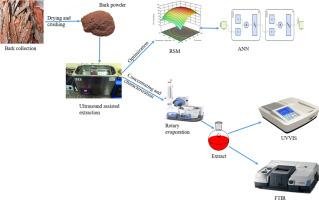响应面法(RSM)和人工神经网络(ANN)在超声辅助提取含羞草金合欢树皮生物活性成分中的应用
IF 3.3
Q2 MULTIDISCIPLINARY SCIENCES
引用次数: 0
摘要
含羞草金合欢树皮(MWTB)是一种丰富的生物活性化合物的来源,以其抗腐蚀、药用特性和皮革鞣制用途而闻名。本研究利用响应面法(RSM)和人工神经网络(ANN)对超声辅助提取(UAE)工艺参数进行优化。通过温度(30 ~ 70℃)、提取时间(10 ~ 60 min)、液固比(0.075 ~ 0.125 mL/g)三个关键因素对提取工艺进行优化。根据提取率(EY)和总酚含量(TPC)对这些参数进行评价。最佳提取条件为50℃,35 min,料固比为0.1。在此条件下,RSM预测提取率(EY)为27.61%,TPC为81.84 mg GAE/g;人工神经网络模型预测提取率为26.88%,TPC为83.33 mg GAE/g。建立了多层感知器(MLP)人工神经网络模型,并采用反向传播算法进行训练,与RSM模型相比,该模型的预测值与实验数据更接近。利用紫外-可见光谱和红外光谱对其进行了植物化学分析。本文章由计算机程序翻译,如有差异,请以英文原文为准。

Application of response surface methodology (RSM) and artificial neural network (ANN) for bioactive compounds recovery from mimosa wattle tree (Acacia Mearnsii) bark using ultrasound-assisted extraction
Mimosa Wattle tree bark (MWTB) is a rich source of bioactive compounds known for their corrosion inhibition, medicinal properties, and use in leather tanning. The current study focuses on optimization of process parameters for extraction of these phytochemicals using ultrasound-assisted extraction (UAE), with the help of response surface methodology (RSM) and artificial neural network (ANN). The extraction process was optimized by varying three key factors: temperature (30–70 °C), extraction time (10–60 min), and solvent-to-solid ratio (0.075–0.125 mL/g). These parameters were evaluated based on extraction yield (EY) and total phenolic content (TPC). The optimum extraction conditions were determined to be 50 °C, 35 min, and a solvent-to-solid ratio of 0.1. Under these conditions, the RSM predicted an extraction yield (EY) of 27.61 % with a TPC of value of 81.84 mg GAE/g, while the Artificial Neural Network (ANN) model predicted a yield of 26.88 % and a TPC of 83.33 mg GAE/g. A multilayer perceptron (MLP) ANN model was developed and trained using the back propagation algorithm, and the predicted values from the ANN model showed closer agreement with experimental data compared to the RSM model. Phytochemical profiling was carried out using UV–Vis and FTIR spectroscopy.
求助全文
通过发布文献求助,成功后即可免费获取论文全文。
去求助
来源期刊

Scientific African
Multidisciplinary-Multidisciplinary
CiteScore
5.60
自引率
3.40%
发文量
332
审稿时长
10 weeks
 求助内容:
求助内容: 应助结果提醒方式:
应助结果提醒方式:


